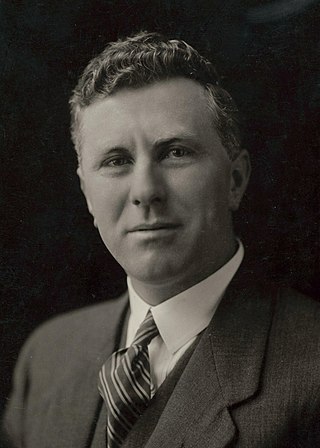Related Research Articles

The House of Assembly, or Lower House, is one of the two chambers of the Parliament of Tasmania in Australia. The other is the Legislative Council or Upper House. It sits in Parliament House in the state capital, Hobart.

Sir Walter Henry Lee KCMG was an Australian politician and member of the Tasmanian House of Assembly. He was Premier of Tasmania on three occasions: from 15 April 1916 to 12 August 1922; from 14 August 1923 to 25 October 1923; and from 15 March 1934 to 22 June 1934.

Sir John Cameron McPhee, KCMG was an Australian politician and member of the Tasmanian House of Assembly. He was Premier of Tasmania from 15 June 1928 to 15 March 1934.

John Blyth Hayes was an Australian politician who served as a Senator for Tasmania from 1923 to 1947. He was President of the Senate from 1938 to 1941. Before entering federal politics, he had been a member of the Parliament of Tasmania from 1913 to 1923 and served as Premier of Tasmania for almost exactly one year, from 1922 to 1923.

James Allan Guy, CBE was an Australian politician who represented the Australian Labor Party in both the Tasmanian House of Assembly and the Federal House of Representatives, before leaving to represent the United Australia Party and then the Liberal Party of Australia in both the House of Representatives and the Senate. His father, James Guy, had also been a Senator.
The 1986 Tasmanian state election was held on 8 February 1986 in the Australian state of Tasmania to elect 35 members of the Tasmanian House of Assembly. The election used the Hare-Clark proportional representation system — seven members were elected from each of five electorates. The quota required for election was 12.5% in each division.

James Ernest Ogden was an Australian politician who was elected to the Tasmanian House of Assembly and the Australian Senate.
The 1976 Tasmanian state election was held on 11 December 1976 in the Australian state of Tasmania to elect 35 members of the Tasmanian House of Assembly. The election used the Hare-Clark proportional representation system — seven members were elected from each of five electorates.
The 1979 Tasmanian state election was held on 28 July 1979 in the Australian state of Tasmania to elect 35 members of the Tasmanian House of Assembly. The election used the Hare-Clark proportional representation system — seven members were elected from each of five electorates. The quota required for election was 12.5% in each division.

The 1912 Tasmanian state election was held on Tuesday, 30 April 1912 in the Australian state of Tasmania to elect 30 members of the Tasmanian House of Assembly. The election used the Hare-Clark proportional representation system — six members were elected from each of five electorates.

The 1913 Tasmanian state election was held on Thursday, 23 January 1913 in the Australian state of Tasmania to elect 30 members of the Tasmanian House of Assembly. The election used the Hare-Clark proportional representation system — six members were elected from each of five electorates.

The 1916 Tasmanian state election was held on Saturday, 25 March 1916 in the Australian state of Tasmania to elect 30 members of the Tasmanian House of Assembly. The election used the Hare-Clark proportional representation system — six members were elected from each of five electorates.

The 1919 Tasmanian state election was held on 31 May 1919 in the Australian state of Tasmania to elect 30 members of the Tasmanian House of Assembly. The election used the Hare-Clark proportional representation system — six members were elected from each of five electorates.

The 1950 Tasmanian state election was held on 6 May 1950 in the Australian state of Tasmania to elect 30 members of the Tasmanian House of Assembly. The election used the Hare-Clark proportional representation system — six members were elected from each of five electorates.

The 1955 Tasmanian state election was held on 19 February 1955 in the Australian state of Tasmania to elect 30 members of the Tasmanian House of Assembly. The election used the Hare-Clark proportional representation system — six members were elected from each of five electorates.

The 1959 Tasmanian state election was held on 2 May 1959 in the Australian state of Tasmania to elect 35 members of the Tasmanian House of Assembly. The number of members were increased from this election from 30 to 35. The election used the Hare-Clark proportional representation system — seven members were elected from each of five electorates.

The 1964 Tasmanian state election was held on 2 May 1964 in the Australian state of Tasmania to elect 35 members of the Tasmanian House of Assembly. The election used the Hare-Clark proportional representation system — seven members were elected from each of five electorates.
The 1916 Tasmanian state election was held on 23 March 1916.
The Tasmanian Labor Party, officially known as the Australian Labor Party (Tasmanian Branch) and commonly referred to simply as Tasmanian Labor, is the Tasmanian branch of the Australian Labor Party. It has been one of the most successful state Labor parties in Australia in terms of electoral success.
This is a list of House of Assembly results for the 1913 Tasmanian election.
References
- ↑ "Assembly Elections, 1916". Tasmanian Parliamentary Library. Retrieved 28 November 2017.